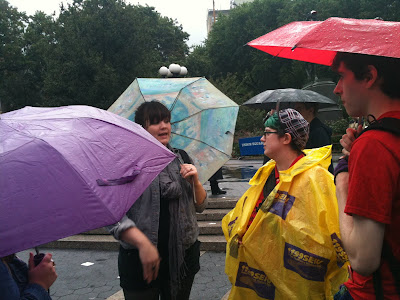Wednesday, October 5
A Sold-Out Newspaper in 2011: Always a good thing?
Tuesday, October 4
PapaCookie: A Public Event at Home, Sit Down and Hear the Noise
Monday, October 3
FOX
the mayor, white shirts, and videos from both sides
http://www.nytimes.com/2011/10/03/nyregion/nypds-white-shirts-take-on-enforcer-role.html?_r=1&ref=nyregion
http://www.nytimes.com/2011/10/03/nyregion/police-too-release-videos-of-arrests-on-bridge.html?ref=nyregion
http://video.nytimes.com/video/2011/10/01/nyregion/100000001084915/wall-street-protesters-speak.html?ref=nyregion
Four City Subway Stations Are Now Online
“For too long the subway system has been an information black hole in our lives,” said MTA Chairman Jay H. Walder in an October press release through Transit Wireless, the company formed specially to “provide a shared wireless infrastructure to enable commercial wireless services for the New York City Transit Authority. But now for AT&T and TMobile wireless customers, four subway stations are freed from that technological void as the first round of cell service connectivity is launched.
According to Transit Wireless, the original plan was to establish wireless capability in all of New York City’s 277 underground subway stations by 2016, however according to reporting done by CBS news, now Transit Wireless and the MTA hope to have total subway coverage finished over the next four years with a total projected cost of 100 to 200 million dollars. The two current service providers, AT&T and TMobile both have 10-year contracts with four additional 5-year renewal options. Transit Wireless stated in their October press release that receiving support from these two major carriers will benefit riders beyond just providing wireless service, but also by providing revenue to the MTA. Currently only the two carriers will be available, however in a press conference, Carmen Bianco, a senior vice president of subway operations for the MTA said they are still in talks with both Verizon and Spring, but that he couldn’t say when the carriers would be available.
Yet individual rider reactions are mixed. “It’s one of the last places you can’t use your cell phone,” Soule Golden, a 28-year old New Yorker said in an interview with the Daily News, “it’s annoying to have to listen to people talking on their cell phones all the time.” Others find it helpful for both simple connectivity and more practically for ensuring accurate directions within subway tunnels. “When I’m going from point A to point B, it’ll be nice to make sure I’m going the right way, since I’m not from the city,” Jessica Beuffkin, a recent New York addition told CBS news. While Bill Bayne, the CEO of Transit Wireless in a press conference said that the additional connectivity will help dramatically with transit safety, “For those of you who see something, down here we can enable you to say something” he said, playing off of the New York subway “see something, say something” theme.
Meanwhile, subway cell phone thefts are at an all-time high, prompting further questions as to what effect wireless connectivity on trains will have on this issue. “It will encourage people to bring [cell phones] out,” subway riders advocate Bill Henderson told Metro New York news in response to connectivity and thefts.
Ultimately, it appears that full-scale subway connectivity is on its way to becoming a reality but its effects on city transportation are still yet to be seen.
The Intrepid, World War II Aircraft Carrier and Space Museum, Houses a Concert
What a Difference a Permit Makes
Of the hundreds of people that shut down two lanes of the Brooklyn Bridge, after police let the marchers onto the bridge, 700 were arrested. In Manhattan the Slut Walkers faced no conflicts with the police.
Leading up to the Slut Walk march the group’s blog, slutwalknyc.com, was inundated with questions from concerned participants. After seeing many arrests and police brutally seemingly targeted towards women future-marchers were worried for their safety. A participant, username onthewing told the group, “My mom is super paranoid about police brutality and whatnot and I have assured her about the fact that we are permitted to be there.” Unlike Occupy Wall Street’s march Slut Walk had the appropriate permits for their march. To ensure the safety of the marchers, most of whom were young women (many of which were volunteering for high school volunteer hours) the group organized marshals education in the law to assist marchers if there were any conflicts with the police.
“…This will not be act of civil disobedience,” organizers assured marchers on the blog, “the police will have little grounds to start anything. However, we are absolutely taking what happened last weekend [the mace incident at the Occupy Wall Street March] into account (especially since they were targeting women specifically) and we have extra-prepared our marshals for everything and anything.”
The lack of clashes between marchers and the police at Slut Walk is even more poignant given the recent treatment of women by law enforcement. Just a year after a officer raped a woman, a week after an officer maced a group of women, and days after it was reported that policemen were stopping women on the street in Park Slope to tell them cover up to protect themselves from the serial rapist who has been targeting women in the area it is refreshing to see cops stand by peacefully as a group of women speak out to defend their rights.
Sunday, October 2
Future Times Square Has Dark Flooring and More Seats
Local Pharmacy Struggles to Remain in Business
New York Ranks Top 10 Smoggiest Cities in America
 |
| Photo by Google Images |
Photos from the SlutWalk





So What If I Drive with One Hand on the Horn?
| Screen Shot of the Noise Service Request Count by Community Board |
"What a Hundred Million Calls to 311 Reveal About New York"
(By Wesley Grubbs and Mladen Balog of Pitch Interactive, 2007)
 |
| Taken By: Stephanie Kun |
Area Code 666
According to the MTA, the expansion is projected to cost anywhere from $100 million to $200 million.


















